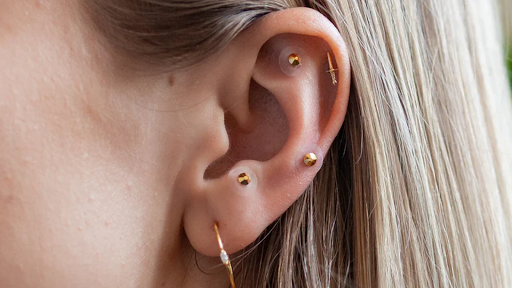Ear seeding is a simple practice where small seeds or beads are placed on specific points of the ear. These points connect to different parts of the body through nerves. Gentle pressure from the seeds helps calm the mind and may affect body systems. Many people use this method to support fertility and improve hormonal balance.
Researchers have studied ear seeding for stress, fertility, and hormone control. Some clinical trials report lower anxiety and better outcomes during fertility treatments like IVF. Scholars explain that ear points stimulate nerves linked to hormone centers in the brain. Previous studies suggest possible improvements in menstrual cycles and ovulation, but scientists also stress that more large studies are still needed.
This gentle method gives hope to couples trying to conceive. It is easy, safe, and can be used along with medical care. The idea that simple ear seeds may support hormones makes the practice both unique and appealing. With growing interest, ear seeding is becoming a modern tool rooted in ancient wisdom.
What ear seeding is, simply
Ear seeding uses seeds, beads, or small pellets. Practitioners attach seeds with tape to auricular points. Those points map to body systems in auricular therapy. Stimuli come from steady pressure. Clients press the seed when they feel stress or discomfort. The method links to auricular acupuncture and auricular acupressure. Both aim to change nerve activity and hormones.
How ear seeding might help fertility
Key idea: stress harms fertility. High stress raises cortisol. Cortisol can shift reproductive hormone signals. Lower stress may restore hormone balance. Ear stimulation can lower anxiety. That change may help ovulation and implantation. Some studies show better IVF outcomes after auricular stimulation, possibly from lower stress and better blood flow to reproductive organs.
Biological pathways behind effects
Ear points connect to nerves. One important link: the auricular branch of the vagus nerve. Stimulating ear points can change vagal activity. Vagal changes can affect the hypothalamic-pituitary axis. That axis controls reproductive hormones. Auricular stimulation may alter cortisol and prolactin levels. Those hormones influence ovulation, menstrual cycles, and the implantation chance. Evidence of neural and hormonal change comes from clinical and laboratory studies of auricular stimulation.
What research shows about fertility outcomes
Researchers tested auricular acupressure in IVF patients. Some randomized trials found less anxiety in treated women. Studies reported higher clinical pregnancy rates in groups that received auricular stimulation. Systematic reviews on acupuncture show mixed results for live birth rates. The overall quality of evidence varies across trials. Factors that matter: study size, blinding methods, and exact protocol. Scientists call for larger, rigorous trials before firm conclusions.
Evidence for hormonal balance and related conditions
Researchers studied auriculotherapy for ovarian function, PCOS, and premature ovarian insufficiency. Trials suggest auricular methods may reduce PCOS symptoms. Some meta-analyses show improved menstrual regularity. Studies on premature ovarian insufficiency report promise, but evidence remains limited. Results vary by method, session length, and seed placement. Overall, auriculotherapy shows potential to support hormonal balance, pending stronger trials.
Safety and side effects
Ear seeding risks appear low. Common effects include mild pain, local skin irritation, and brief discomfort. Serious events are rare. Infection risk lowers with clean technique. Pregnant women should use caution. Always consult a licensed practitioner when combining auriculotherapy with fertility treatments. Several clinical trials report no major adverse events.
Limits of current research
Many studies show small samples. Some trials lack proper blinding. Some use different ear points across studies. Those differences make comparisons hard. Researchers note placebo effects can influence results. The exact biological mechanism needs more proof. High-quality randomized controlled trials remain scarce. That gap limits clinical certainty.
Practical advice for people trying to conceive
Seek qualified care. Choose practitioners who follow hygiene standards. Use ear seeding as a supportive measure. Focus on proven fertility steps too. Examples: medical evaluation, balanced diet, weight management, sleep, and stress reduction. Do not stop prescribed fertility medicine without a doctor’s OK. Track results. Note mood, cycle changes, and any side effects.
How to combine ear seeding with fertility care
Discuss ear seeding with your fertility team. Use seeds as an adjunct to medical treatment. Consider short daily self-pressure on seeds for stress relief. If you use IVF, try auricular methods for anxiety before embryo transfer. Keep clear notes. Share them with your doctor at follow-up visits.
Key sources that inform these points
- Auricular acupressure reduced anxiety and improved IVF outcomes in a randomized study.
- Auriculotherapy may lower stress and support assisted reproductive treatment outcomes.
- Systematic reviews find low to modest evidence that acupuncture can increase clinical pregnancy rates in IVF. More data is needed for live birth rates.
- Auricular stimulation affects vagal activity and autonomic function. That link may explain neuroendocrine changes.
- Recent clinical trials show auriculotherapy may help PCOS symptoms compared with some standard treatments.
Conclusion
Ear seeding offers a simple, low-risk way to target stress and to nudge the nervous system. Research links those effects to modest benefits in fertility care. Trials show promise for anxiety reduction and for some fertility outcomes. High-quality evidence for direct hormonal cures does not exist yet. Use ear seeding as support. Keep main trust in proven medical care. Track changes closely. Use data from each cycle to guide choices. That blend of careful practice and clear evidence gives the best chance to improve fertility while staying safe.

Jennifer Marshall is a friendly and talented journalist who loves telling stories. She is an expert in writing biographies that make people’s lives shine. With clear and simple words, Jennifer creates engaging stories that everyone can enjoy. With 9 years of experience, her passion for writing helps her connect with readers and share inspiring tales.
